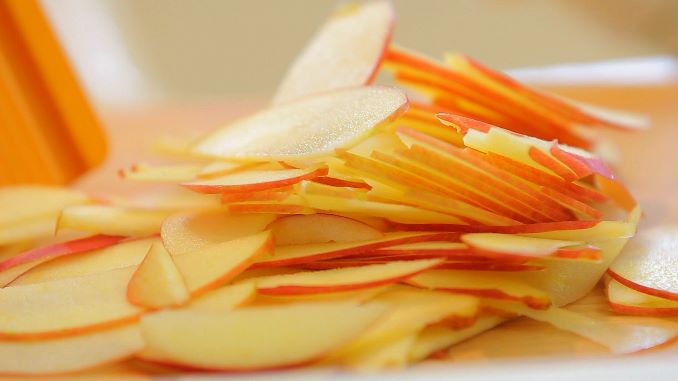If you want a simple rule to follow, then you can opt for 1⁄4 to 1 inch (0.64 to 2.54 cm) thick slices when slicing apples to make your pie.
But there really is no strict answer here.
And most chefs will say that there are two basic ways you could go for: long, thin slices or small, chunky dice. This really depends on what kind of filling you prefer.
The former will give you an evenly-layered, cleaner-looking interior.
When you take a cross-section of a pie, the fruit slivers will look so pretty overlayed with syrupy cinnamon.
This will also have a more cake-y mouth feel in the sense that the fruit has softened well and it all comes together nicely.
The latter would be more rustic-looking since it’s all chunky cubes.
Also, you’d have a pie with more bites because you’d still be getting individual apple pieces.
Again, either way works.
Below are some ways on how you can accomplish this perfectly.
Related: An A-to-Z List of Fruits (With Pictures)
Initial Prep
Wash the fruits under the tap. Peel it using a paring knife or a peeler. Core it with a corer or cut the fruit in quarters then carve out the middle part with a paring knife.
The Slicing
If you’re going for chunks, cut the piece into eight wedges.
Lay one flat on the board, facing you like a smiley mouth, then cut pieces measuring two centimeters wide.
Do the same for all the others.
If you’re going for slices, slice the fruit in half.
Lay the piece flat on the board and then, with your knuckles as a guide, make thin slices from one end until you finish the whole thing using a Chef’s knife or a Japanese-style Nakiri.
Remember: a sharpened and well-honed knife is a great friend so do this before you attempt any chopping board chore.
A blunt blade will fail at the task and, worse, could hurt you.
Try Other Tools
Not everyone is very handy with a knife. Those who aren’t could use the mandolin or the food processor.
Start with the initial prep as described above.
If you’re going for the mandolin, cut the fruit into quarters and then stick all the pieces onto the holder.
Once secured, run it over the mandolin in a see-saw fashion until you finished the whole piece.
The holder can be more of a hassle than a help at times. If it’s more of the former for you, use those cut-resistant gloves instead.
If you’re doing this in a food processor, try to fit in apple wedges inside the chute.
Put the pusher in place, turn on the machine and gently push the pieces down until the slices are deposited inside the container.
—
Aside from the shape of the apple slices, there are other factors that you should take into consideration when it comes to great fillings. Here are some of those:
The Right Acidity
When choosing apples, go for those that are sweet but slightly tart.
Acidic fruits tend to have more pectin in them, giving off a thicker syrup in the filling.
These also do not brown fast so you’ll have a better-looking interior when the pie is sliced.
The Golden Delicious is a very good example of a variant that has a good mix of sweetness and tartness.
The Right Texture
It’s best to go for firmer apples so that it doesn’t go that mushy in heat.
Granny Smith, Northern Spy, and Cortland are great options in relation to this because they stay firm even after sauteing and baking it.
Softer ones like McIntosh and Red Delicious tend to go mushier. These two are better for sauces and jams than pie fillings.
The Right Flavor Balance
It’s also very important to taste your fruit before you actually cook it.
Granny Smith, for instance, tends to be slightly tart.
Adding a bit more sugar to the mix is a good idea.
If you have a sweeter-tasting apple, do the opposite.
What some people actually do is mix different apple variants to get the right flavor and texture.
Braeburn and Honeycrisp are well-matched, giving your pie an interesting complex flavor profile.
Cinnamon and nutmeg create depth of flavor. It also gives that oh-so-warm feeling when you take a bite.
The Perfect Crust
Different kinds of fat are mixed in the dough.
Some use butter and lard, others use butter and shortening, and so on.
But an all-butter dough is still the best. That’s what makes them unbeatable flaky pie crust.
Conclusion
There are very few things more satisfying than a warm slice of apple pie topped with a dollop of vanilla ice cream at any time of the day, during any season.
Give the tips above a try the next time you make this pie at home.

